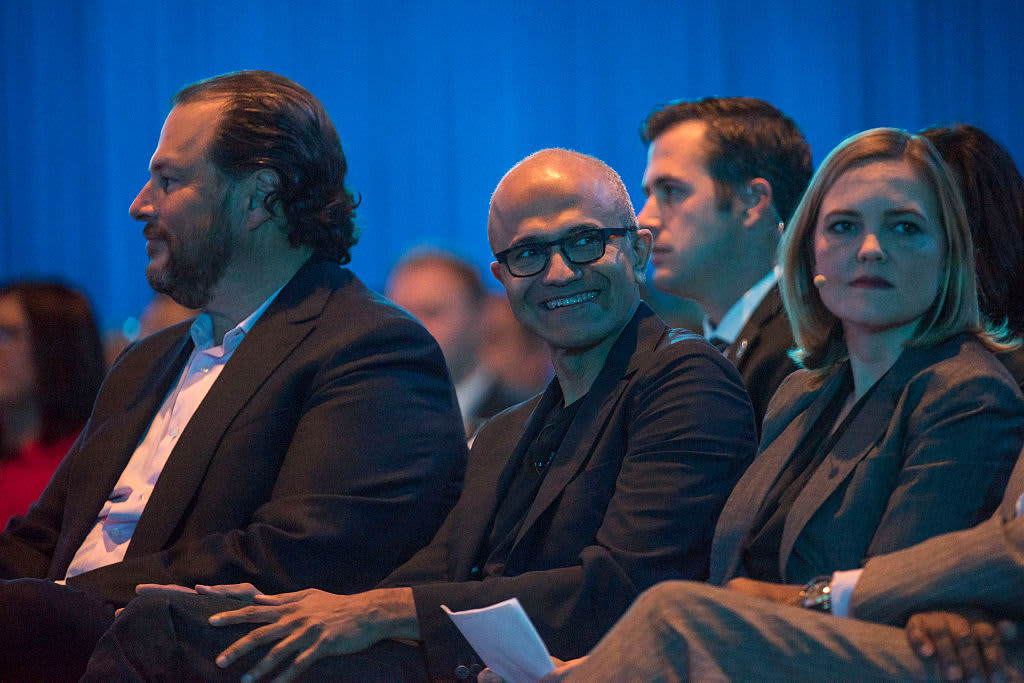Microsoft sales changes could help it challenge Salesforce in cloud software

Marc Benioff, chairman and chief executive officer of Salesforce.com, left, and Satya Nadella, chief executive officer of Microsoft Corp., center, watch a presentation during Salesforce’s Dreamforce conference in San Francisco on Sept. 16, 2015.
David Paul Morris | Bloomberg | Getty Images
Microsoft might finally be ready to compete hard in Salesforce‘s core business of customer relationship management (CRM) software, which helps businesses track sales and support.
Microsoft is directing its salespeople to get existing customers to adopt its Dynamics products, a major Microsoft partner indicated to analysts at RBC Capital Markets. RBC didn’t name the partner, but these players typically re-sell Microsoft software, often in conjunction with consulting services, hardware, or other software.
The push could lift Microsoft’s Commercial Cloud, a group of cloud products that now represents over one-third of the company’s total revenue. It could also make things harder for Salesforce, despite the fact that Microsoft has had little luck displacing the dominant CRM player after nearly 20 years of efforts.
“I think what’s happened is it’s a new priority,” RBC’s Alex Zukin told CNBC in an interview on Thursday. He and his colleagues have the equivalent of a buy rating on Microsoft stock.
Zukin said the unnamed Microsoft partner told the analysts that Microsoft’s senior leadership must approve any enterprise license renewal that leaves out Dynamics, which includes CRM and other business management software, and PowerApps, a tool that non-technical people can use to build applications. Microsoft promotes PowerApps, a product introduced in 2015, in a bundle called the Power Platform.
A person who works with Microsoft customers told CNBC he has seen Microsoft aggressively promote Dynamics and PowerApps into as many enterprise agreements as possible. This person declined to be named discussing confidential customer information.
Microsoft sales leaders want to make sure their account teams are talking with clients about the cloud-based Dynamics 365 cloud service and the Power Platform, including at the time of renewal. This effort became more pronounced when the company’s current fiscal year began in July, according to a person close to the company.
“Microsoft engages executives throughout the agreement renewal process and we routinely check in with salespeople to make sure they’re exploring Dynamics 365 and Power Platform prior to each deal’s completion,” Microsoft spokesman Frank Shaw told CNBC in an email on Tuesday. “This is about being efficient with customer engagement and ensuring awareness of the growing interest we see in these offerings, without introducing any change to the structure of customer agreements.”
Microsoft doesn’t disclose the size of Power Platform, but the company does give some visibility into Dynamics 365. In the second quarter it grew 38% from the year-ago period, faster than most other Microsoft products.
In the 2020 fiscal year, which ended on June 30, total Dynamics revenue exceeded $3 billion, with more than 60% — an implied $1.8 billion or more — coming from Dynamics 365, Microsoft’s finance chief, Amy Hood, told analysts on a conference call in July.
In the 2000s, current CEO Satya Nadella played a key role in the development of Dynamics. Since becoming CEO in 2014, though, he hasn’t made Dynamics a major focus, doing much more to promote the Azure cloud. (During the call in July he mentioned Azure 22 times and Dynamics 10 times.) Meanwhile, Salesforce has taken more of the market for customer relationship management software.
Earlier this month, Salesforce CEO Marc Benioff published a tweet containing a chart that shows Salesforce’s expansion in the CRM market, based on data from research company IDC. The data shows in 2019 Salesforce controlled 18.4% of the market in 2019, while Microsoft held 3.7%. An IDC spokesperson did not have more recent data available.
The two companies have a history of strident competition interspersed with moments of cooperation. Microsoft looked at buying Salesforce in 2015 but a disagreement on price got in the way of a deal. In 2016 Microsoft beat Salesforce in an attempt to buy LinkedIn, paying $27 billion in its largest acquisition to date. But Salesforce has also integrated with Microsoft’s Office 365, and last year Salesforce said it would use Azure.
When Microsoft gets companies to use Azure and modern Office components such as the cloud-only Teams communication app, it’s now able to effectively move backward into selling them on Dynamics, Zukin said.
He said that if Microsoft truly desires to dominate the market, it could just buy Salesforce, but he doesn’t think Microsoft would want to put itself under the regulatory spotlight alongside other large technology companies such as Amazon and Google.
Microsoft reports third-quarter earnings on Oct. 27.
WATCH: Bill Gates on regulating Big Tech: ‘We’re in uncharted territory’